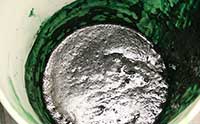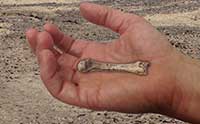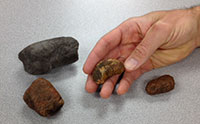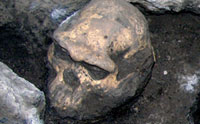A new technology produces diesel fuel from algae in mere minutes using heat and pressure, thus calling into question the secular claim that fossil fuels have developed over millions of years. More… …read more Read more here: icr.org
A global sequence? …read more Read more here: creation.com
The Messel Pit preserves animals suddenly and catastrophically buried in the wake of the global Flood. …read more Read more here: AIG Daily
A human hand bone found in northern Kenya surprised researchers when it surfaced in rock layers assigned a supposed age of about 1.4 million years, making it the oldest dated human bone but still “young” enough to challenge evolutionary dating methods. More… …read more Read more here: icr.org
Is uniformitarianism really a true understanding of the rock and fossil records? Did it really take long ages to lay down all these rock layers? …read more Read more here: AIG Daily
“The more one reads about such marvels of design through out nature the more absurd the idea becomes that they arose by chance.” Admin Trilobites, described by Stephen Jay Gould as ‘everyone’s favourite invertebrate fossil,’ are a class of marine arthropods which are often well preserved and of striking appearance.1,2They are believed to be extinct. They are mostly between 10 and 50 mm long (3/8 to two inches) although a few species attained a length of 750 mm (2 1/2 feet). Trilobites are characterized by a ridged carapace, or shell, made of chitin, divided into three lobes which give the [More]
Several discoveries and observations from 2013 point clearly to a recent creation of planet Earth. More… …read more Read more here: icr.org
A group of paleontologists reported the discovery of concentrated fields of fossilized dung, called coprolite, in Argentina. The closely-spaced dung piles are seen as evidence of gregarious behavior from large herbivores, but does the great Flood provide a better explanation? More… …read more Read more here: icr.org
What does the stratigraphy of fossils suggest about the placement of the Flood/post-Flood boundary in the rocks? …read more Read more here: creation.com
The formation in Virginia called Natural Bridge has been a popular tourist destination in the United States for more than 200 years.1 A small stream, Cedar Creek, flows beneath the arch. A nearby sign gives some of the arch’s vital statistics including its height, length and weight. These facts are easy to check: just compare its size with someone standing underneath. The sign also says the arch is “estimated to be at least 500 million years old.”2 Unlike its dimensions, it is impossible to check this age because no-one was there when the arch was carved. It was geologists who [More]
Does the Chesapeake Bay crater memorialize a meteorite impact from the time of Noah’s Flood? …read more Read more here: AIG Daily
Reliable indicators of age in the rocks? …read more Read more here: creation.com
The discovery of fresh blood in a spectacular mosquito fossil strongly contradicts its own “scientific” age assignment of 46 million years. What dating method did scientists use, and did it really generate reliable results? More… …read more Read more here: icr.org
A site in Dmanisi, in the country of Georgia, yielded skulls reported to be the earliest human fossils found outside Africa. The researchers asserted that “skull 5” is so different from other humans that it significantly widens the range of variation within ancient mankind. However, seven observations question whether or not skull 5 was really human. More… …read more Read more here: icr.org
Answering criticisms. …read more Read more here: creation.com
In spite of what the tourist sign says. …read more Read more here: creation.com
Archaeopteryx gets its walking papers at Los Angeles conference. …read more Read more here: AIG Daily
Dr. Andrew Snelling explains how radioactive dating methods may help us derive not absolute but relative ages of rocks. …read more Read more here: AIG Daily
Researchers claim to have found the world’s oldest big cat fossil in Tibet. They dated their snow leopard skull discovery at around 4.4 million years. But did they get this number through direct and objective scientific procedures? More… …read more Read more here: icr.org
A critique of David Montgomery’s GSA-Today attack on creationist geology. …read more Read more here: creation.com
Smithsonian’s list of historic icons that shaped America credits the Burgess Shale with putting us in our rightful place. …read more Read more here: AIG Daily
When it comes to evidence, many people think that the fossils prove evolution. You may have seen a diagram of the geologic column figure 1 with pictures of plants and animals showing how evolution progressed over millions of years. It gives you the impression that fossils are always found in the same definite order and that no fossils are ever found ‘in the wrong place’. You may be surprised to learn that fossils are being found “in the wrong place” all the time. Out of place, that is, compared with the areas, or ranges, shown for them on the geological [More]
Thousands of years? Nope-just decades …read more Read more here: creation.com
Does the curious mosaic cobbled from the Dmanisi dig demonstrate we are all one family? …read more Read more here: AIG Daily
Remarkably advanced tyrannosaur too low on the evolutionary staircase complicates dinosaur lineage. …read more Read more here: AIG Daily
Stunning and controversial human skull fossils from the country of Georgia will force scientists to rethink everything they know about the story of human evolution. More… …read more Read more here: icr.org
How did birds get their wings? This “classic major evolutionary transition” fails to take flight in the fossil record. …read more Read more here: AIG Daily











































